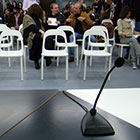The Lab of environmental communication and audiovisual documentation (LECAD),
the Laboratory of Multimodal Design and Research of Hybrid Enviroments (escape lab),
Department of Architecture, University of Thessaly
and the ART/ European Animation Center
organises the
"AND YET IT MOVES - 1st Animation Marathon"
symposium.
The meeting will be held at the Department of Architecture, University of Thessaly, Volos on Friday, 4th of December 2015.
Within the course 'TRACES AND PLANS", on Monday, 11.30.2015 at 15.30 in the Amphitheatre of the Department of Architecture Avraam Pavlidis will give a lecture and a presentation of his projects.
Avraam Pavlidis is an awarded photographer.
Made in Şişhane Project
Alternative Design Practices for Safeguarding the Craft Neighborhoods in Istanbul
Aslı Kıyak İngin, Architect, Lecturer
Wednesday, 11/11, 20:00, Amphitheatre
Workshop “Letting go”: Control and its loss in the context of musical actions
Panayiotis Kanellopoulos, musician, associate professor, Department of Pre-School Education, University of Thessaly.
The workshop is part of the course “Audiovisual Representations and Image Processing Techniques”, Tuesday 10/11/14, 18:00 -21:00pm, Department of Architecture
How is music written down? Is the score an accurate representation of the music? Which are the logics that underpin different ways of written representation of musical events? What is being gained and what is being lost when a piece of music is notated? Which are the aspects that different forms of notation seek to control and why? Who controls what escapes control of the 'composer'? Which are the aspects that different forms of written musical representation 'let go'? And why? Looking at different ways of notating music (from Bach to Cardew) we aim at discussing the issue of controlling (or refusing to control) different aspects of the musical material; this discussion is going to lead us to a practical experimentation with ways of controlling noise so as to render it 'musical'. We end by creating a little piece that addresses the issue of the relationships between music, noise and multitude.
See the workshop’s poster.
Panagiotis A. Kanellopoulos received his M.A. and Ph.D. in Music Education from Reading University (UK). His research focuses on developing socio-cultural perspectives on children’s musical improvisation, on ethnographic approaches to young people’s musical creativity and on collective improvisation and composition as a form of socio-political musical practice. He has co-edited the volume Arts in Education, Education in the Arts (Nissos, 2010, in Greek) and has published articles in international publications and leading scholarly journals (including Psychology of Music, Philosophy of Music Education Review, British Journal of Music Education, Action Criticism and Theory for Music Education, Educational Philosophy and Theory). He is active as a mandolinist, performing and recording in a variety of musical contexts. Panagiotis has led many experimental educational workshops that focus on collective free improvisation with variable forces, in a wide range of venues and contexts. He currently serves as an Assistant Professor of Music Education at the University of Thessaly, Greece, and is co-chair of ISPME (International Society for the Philosophy of Music Education).
Friday 3 - Saturday 4 July 2015
Tsalapatas Factory, Volos, Greece, University of Thessaly
The Inernational Scientific Conference is organized by the Laboratory of Environmental Communication and Audiovisual Documentation (LECAD- EPEOT) of the Department of Architecture, University of Thessaly in collaboration with the Social Anthropology Laboratory and Oral History Archive at the Department of History, Archaeology and Social Anthropology (IAKA), University of Thessaly, and with the Department of Architecture of the Aristotle University of Thessaloniki.
Additional info:
Anne Lacaton will present ongoing work of the office Lacaton Vassal (Paris) that illustrate their interest in the issues of INHABITING, USE, PLEASURE, and FREEDOM.
Who
Anne Lacaton
Co-Principal, Lacaton & Vassal architects, Paris
When
Thursday, June 11, 2015, 17:30
Where
Auditorium, Department of Architecture
Read the poster.
And yet it moves: Approaching space through animation
29/5/2015
Dept. of Architecture
The Laboratory of Multimodal Design and Research on Hybrid Environments (EscapeLab) and the Laboratory of Environmental Communication and Audiovisual Representation (LECAD), Department of Architecture, University of Thessaly, organise the "AND YET IT MOVES: Approaching space through animation" symposium.
The theme focuses on contemporary spatial approaches through animated movies. Specifically, the goal is to shed light on the way space is represented by using various techniques and technologies.
The meeting will be held at the Department of Architecture, University of Thessaly, Volos on Friday, 29th of May 2015.


